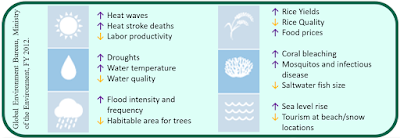As
can be seen in this hypothetical weather report for 2050 from the World Meteorological Organization, despite a successful 80% greenhouse gas emission reduction,
climate change in Japan has led to elongated heat waves and droughts of over 50
days, and the number of annual heat-related deaths has risen to 6,500. The
increased average temperature is affecting the environment as well, with trees
delaying their traditional autumnal shift in colors, which consequently has
shifted tourism patterns. Coral reefs in Okinawa have become affected by
irreversible bleaching and are attracting less tourists. Rice yields have
increased but the quality has decreased. The average annual number of cyclones
making landfall has increased from 2.6 between 1971 and 2000, to 5.2 between
2031 and 2050, and the number of category 4 and 5 storms (super typhoons) has
doubled, which has caused increased deaths, infrastructure damages and power
blackouts. While the cyclones bring a temporary relief to heat waves, their
destruction includes storm surges up to 10 meters. In addition, the sea level
has risen by 40 cm, diminishing beach areas and requiring additional flood
protective infrastructure for a great deal of the nearly 30,000 km coastline.
However, due to Japan’s long experience in preparing for natural hazards and
investing in mitigation, a larger share of the population now lives in safer
areas, through combined demographic and infrastructural plans.
This is the best case future for us and our children we are trying to make happen today. The effects are summarized in the figure below:
References
Rice
yields and other effects on flora and fauna: Climate change and its impact in Japan, Financial Year 2012, Ministry of the Environment.

No comments:
Post a Comment